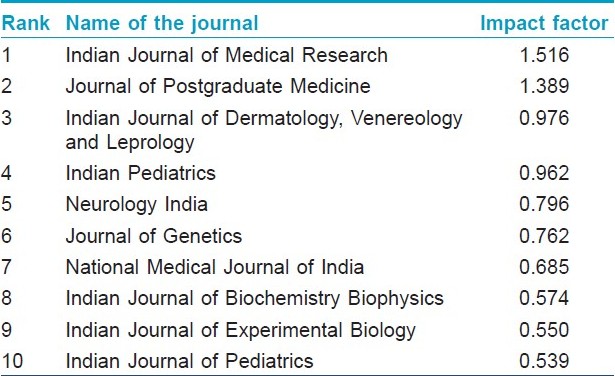Translate this page into:
First impact factor of Indian Journal of Dermatology, Venereology and Leprology
Correspondence Address:
Devinder Mohan Thappa
Editor-in-Chief, Indian Journal of Dermatology, Venereology, and Leprology, Professor and Head, Department of Dermatology and STD, JIPMER, Pondicherry - 605 006
India
| How to cite this article: Thappa DM. First impact factor of Indian Journal of Dermatology, Venereology and Leprology. Indian J Dermatol Venereol Leprol 2011;77:1-2 |
The impact factor is one of the measures for assessing the scientific contribution of a journal. It is based on the premise that if the papers published in a particular journal are cited more frequently in the scientific literature that follows, then that journal has had a greater impact on the scientific field that it relates to. [1] Only research articles, original case reports, technical notes and reviews are considered citable items of a journal. Commentaries, editorials, correspondence/letters to editors are considered non-citable. The impact factor basically is the ratio of total number of citations in the previous two years from the given year for which it is calculated, to all the citable articles published in those two years. From the above equation it is clear that the reduction in the number of citable articles in the denominator will increase the impact factor. Consequently, editorial board is compelled to look for priority among the citable articles they receive. Lack of originality in the citable articles may reduce the impact factor. Hence, the editorial board prepares manuscripts with high priority that earns good impact. The editors generally restrict the number of review and original articles unless they are of exceptionally high standard.
Basic science subjects like Biochemistry, Cell biology and Immunology have a very high impact factor, whereas the specialty journals have lesser impact factor. The Journal of Investigative Dermatology which publishes articles related to basic cutaneous research has the highest impact factor amongst the dermatology journals. Similarly, sub-specialty journal cannot be compared with its parent specialty journal for its impact factor. For example, Contact Dermatitis or Pediatric Dermatology journal cannot be compared with the Archives of Dermatology or British Journal of Dermatology.
Impact factor of a journal is periodically monitored by an organization called Thomson Reuters [formerly International Scientific Institute (ISI)], Philadelphia, founded by Eugene Garfield. In 2009, Journal Citation Reports (JCR) Science edition from Thomson Reuters included 68 journals from India. The Journal of Biosciences was the topmost with an impact factor of 1.956. Amongst the biomedical journals from India, Indian Journal of Medical Research was the topmost with an impact factor of 1.516 and was ranked number two in the hierarchy of journals listed in this report from India [Table - 1]. Following Indian Journal of Medical Research, the second biomedical journal from the top was Journal of Postgraduate Medicine (impact factor 1.389) and the third one was Indian Journal of Dermatology, Venereology and Leprology (impact factor 0.976). It is a matter of rejoice and pride for me as well as IADVL members that in its first year of appearance in JCR, [2] the journal has reached to this level.

I thank the contributors, editors and our publisher, Medknow Publications, for their efforts to improve the quality of this journal and achieving the first good impact factor of 0.976 for IJDVL.
A large part of the success of the IJDVL has been due to the persevering efforts of Dr. DK Sahu and his dedicated team at Medknow Publications and Media Pvt. Ltd. The IJDVL manuscript submission site is being upgraded continuously by them and I am sure you must be happy with the new looks of the website. Now articles are not accepted directly as done earlier. They follow the path of pre-acceptance during which edited articles are proof-read by authors and related queries are answered. During this phase, one can also upload the high resolution images. It is now possible during new article submission time itself to upload the images of 4 MB size, thus avoiding the need of re-submission of high resolution images later on. Now, in the table of contents, most cited, most downloaded and search pages have become common features. Some of the articles have been labeled as "Popular" articles. Website has been optimized for mobile devices.
My thanks are due to all our sponsors for the 2010 print version, especially Gracewell, Galderma India Pvt. Ltd., Glaxo SmithKline (GSK), Dr. Reddy′s laboratories Ltd. and Timpac Health Care Pvt. Ltd., for their financial backing of this scientific activity. Special thanks to Systopic Labs Pvt. Ltd. for sponsoring mailing of IJDVL to our IADVL members and Galderma India Pvt. Ltd. for sponsoring the website http://www.ijdvl.com .
I take this opportunity to congratulate Drs. Sujay Khandpur, Vinod K Sharma, Alpana Sharma, Gaurav Pathria, and Abhigyan Satyam, authors of the original article titled "Comparison of enzyme-linked immunosorbent assay test with immunoblot assay in the diagnosis of pemphigus in Indian patients", for winning the Bishnupriya Devi Award for best paper published in IJDVL during the year 2010. I also congratulate Drs. Nilendu Sarma and Sanjay Ghosh, authors of the article "Clinico-allergological pattern of allergic contact dermatitis among 70 Indian children", for winning the Indubala Memorial Award for best paper published in IJDVL in 2010 in the subject of occupational/contact dermatitis. Last but not the least, I thank all the contributors for their unstinted support during the year, which is pivotal to the continued success of our journal.
I take this opportunity to wish all of you a very happy, healthy and prosperous new year!
| 1. |
Kanthraj GR. Journal impact factor. Indian J Dermatol Venereol Leprol 2006;72:322-5.
[Google Scholar]
|
| 2. |
Khopkar U. IJDVL gets into the Science Citation Index Expanded! Indian J Dermatol Venereol Leprol 2008;74:1.
[Google Scholar]
|
Fulltext Views
4,502
PDF downloads
2,006





